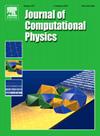A high order ensemble algorithm for dual-porosity-Navier-Stokes flows
IF 3.8
2区 物理与天体物理
Q2 COMPUTER SCIENCE, INTERDISCIPLINARY APPLICATIONS
引用次数: 0
Abstract
In this paper, we introduce and analyze an efficient high-order ensemble algorithm incorporating the semi-implicit spectral deferred correction (SDC-Ensemble algorithm) tailored to simulate flows exhibiting multiple realizations within the stochastic dual-porosity-Navier-Stokes system. This framework accommodates uncertainties stemming from initial conditions, forcing terms, interface boundary conditions and the hydraulic conductivity tensor. By consolidating all realizations into a unified coefficient matrix at each time step, the SDC-Ensemble algorithm significantly diminishes computational overhead compared to traditional methods that treat each realization independently, while preserving high-order accuracy. Furthermore, it disentangles the dual-porosity-Navier-Stokes system into three manageable sub-physics problems, thereby reducing the dimensionality of linear systems and facilitating parallel computation. Employing some novel techniques, this paper also provides a comprehensive stability analysis for the proposed method without relying on the theoretical stability results of lower-order ensemble algorithms. Numerical experiments corroborate the theoretical findings and illustrate the applicability of the algorithm and its features to flow problems in multistage fractured horizontal wellbore with appropriate boundary/interface conditions.
求助全文
约1分钟内获得全文
求助全文
来源期刊

Journal of Computational Physics
物理-计算机:跨学科应用
CiteScore
7.60
自引率
14.60%
发文量
763
审稿时长
5.8 months
期刊介绍:
Journal of Computational Physics thoroughly treats the computational aspects of physical problems, presenting techniques for the numerical solution of mathematical equations arising in all areas of physics. The journal seeks to emphasize methods that cross disciplinary boundaries.
The Journal of Computational Physics also publishes short notes of 4 pages or less (including figures, tables, and references but excluding title pages). Letters to the Editor commenting on articles already published in this Journal will also be considered. Neither notes nor letters should have an abstract.
 求助内容:
求助内容: 应助结果提醒方式:
应助结果提醒方式:


